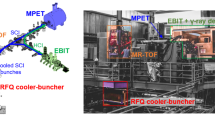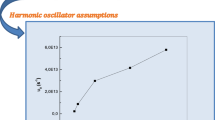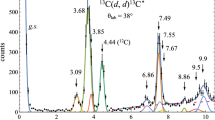Abstract
A model of rotational potential that represents an analog of the pseudopotential for localization of a model of diatomic particle with rigid bond in a plane quadrupole radio-frequency trap is considered. It is shown that the effective rotational potential can be used to describe dynamics of various diatomic particles with different centers of mass and charges. Comparison of the model of pseudopotential for localization of a single ion and the proposed model of the effective rotational potential for diatomic structure is used to determine additional positions of quasi-equilibrium for the center of mass of the diatomic particle and orientation angle of the molecule. Additional positions of quasi-equilibrium substantially affect dynamics of charged structure localized in the field of a plane quadrupole ion trap.



Similar content being viewed by others
REFERENCES
O. V. Boyarkin and V. Kopysov, Rev. Sci. Instrum. 85, 033106 (2014).
B. M. Mihalcea, L. C. Giurgiu, C. Stan, G. T. Vişan, M. Ganciu, V. Filinov, D. Lapitsky, L. Deputatova, and R. Syrovatka, J. Appl. Phys. 119, 114303 (2016).
M. Salhi, A. Passian, and G. Siopsis, Phys. Rev. A 95, 033416 (2015).
I. Jorge, E. M. Casas, M. Villar, I. Ortega-Pérez, D. López-Ferrer, A. Martinez-Ruiz, M. Carrera, A. Marina, P. Martinez, H. Serrano, et al., J. Mass Spectrom. 42, 1391 (2007).
D. L. Marshall, J. T. Saville, A. T. Maccarone, R. Ailuri, M. J. Kelso, T. W. Mitchell, and S. J. Blanksby, Rapid Commun. Mass Spectrom. 30, 2351 (2016).
P. Lützow, M. Schnell, and G. Meijer, Phys. Rev. A 77, 063402 (2008).
E. S. Phillips, R. J. Hendricks, A. M. Abdulla, H. Ohadi, D. R. Crick, K. Koo, D. M. Segal, and R. C. Thompson, Phys. Rev. A 78, 032307 (2008).
Yu. V. Rozhdestvenskii and S. S. Rudyi, Tech. Phys. Lett. 43, 748 (2017).
I. I. Blekhman and V. S. Sorokin, Proc. IUTAM 19, 75 (2016).
P. Nagornykh, J. E. Coppock, and B. E. Kane, Appl. Phys. Lett. 106, 244102 (2015).
I. Alda, J. Berthelot, R. A. Rica, and R. Quidant, Appl. Phys. Lett. 109, 163105 (2016).
E. J. Alvarez and J. S. Brodbelt, J. Mass Spectrom. 30, 625 (1995).
B. M. Mihalcea and G. G. Vişan, Phys. Scr. 140, 014057 (2010).
K. Shah and H. Ramachandran, Phys. Plasmas 16, 062307 (2009).
Funding
This work was supported by the Ministry of Education and Science of the Russian Federation (project 3.821.2014/K), grant 074-U01 for Leading Universities of the Russian Federation, and the Russian Foundation for Basic Research (project no. 17-02-00598 А).
Author information
Authors and Affiliations
Corresponding author
Ethics declarations
The authors declare that there is no conflict of interest.
Additional information
Translated by A. Chikishev
EQUATION FOR EFFECTIVE ROTATIONAL POTENTIAL IN SPHERICAL COORDINATES
EQUATION FOR EFFECTIVE ROTATIONAL POTENTIAL IN SPHERICAL COORDINATES
We consider coordinates of the compete separation of motion (expression (10)):
As was mentioned, general secular motion of trapped charged particle (\(\bar {X}\), \(\bar {Y}\), \(\bar {\psi }\)) is described using a combination of the slow component of motion related to the interaction with dc component of electric field (X, Y, ψ) and additional force induced by fast oscillating components (f(\(\epsilon \)(x, y, ψ))) (analog of pseudopotential (9)). When a particle is localized in the presence of electric field at zero dc voltage across electrodes, terms (\(\bar {X}\), \(\bar {Y}\), \(\bar {\psi }\)) are zeros. Thus, the secular motion of a diatomic charged particle is determined by resulting force of fast oscillations ( f(\(\epsilon \)(x, y, ψ))). Substituting coordinates (10) in original equations of motion (6)–(8), we derive new equations of motion. Without loss of generality, we consider only the equation of motion along the OX axis written as
Evidently, derivative \(\frac{{{{d}^{2}}}}{{d{{\tau }^{2}}}}X(\bar {X},\)f(\({{\epsilon }_{x}}\))) does not explicitly depend on dimensionless time and the acceleration related to fast oscillating terms is given by the following expression owing to smallness or absence of terms characterized by dc voltage \(\bar {X}\):
The rate of fast oscillations with respect to generalized coordinate x can be represented as a function of slow components in the following way (for convenience, we use notation X(f(\({{\epsilon }_{x}}\))) = X and ψ(f(\({{\epsilon }_{\alpha }}\))) = ψ):
With allowance for the equations of motion along generalized coordinates, we represent the total kinetic energy of fast oscillations as
Function (f(\(\epsilon \)(x, y, ψ))) that characterizes the effect of fast oscillating components on the secular motion is determined by averaging of the kinetic energy of fast oscillations. The function that represents the effective potential can be written as (see expression (11))
Substituting generalized center-of-mass and angular coordinates, we obtain an expression for the effective potential energy:
To simplify the further analysis, we introduce dimensionless spherical coordinates, where radius R is normalized by the radius of the RF trap:
Then, the effective potential is represented in the spherical coordinates as
Rights and permissions
About this article
Cite this article
Vasil’ev, I.A., Kushchenko, O.M., Rudyi, S.S. et al. Effective Rotational Potential of a Molecular Ions in a Plane Radio-Frequency Trap. Tech. Phys. 64, 1379–1385 (2019). https://doi.org/10.1134/S1063784219090202
Received:
Revised:
Accepted:
Published:
Issue Date:
DOI: https://doi.org/10.1134/S1063784219090202




